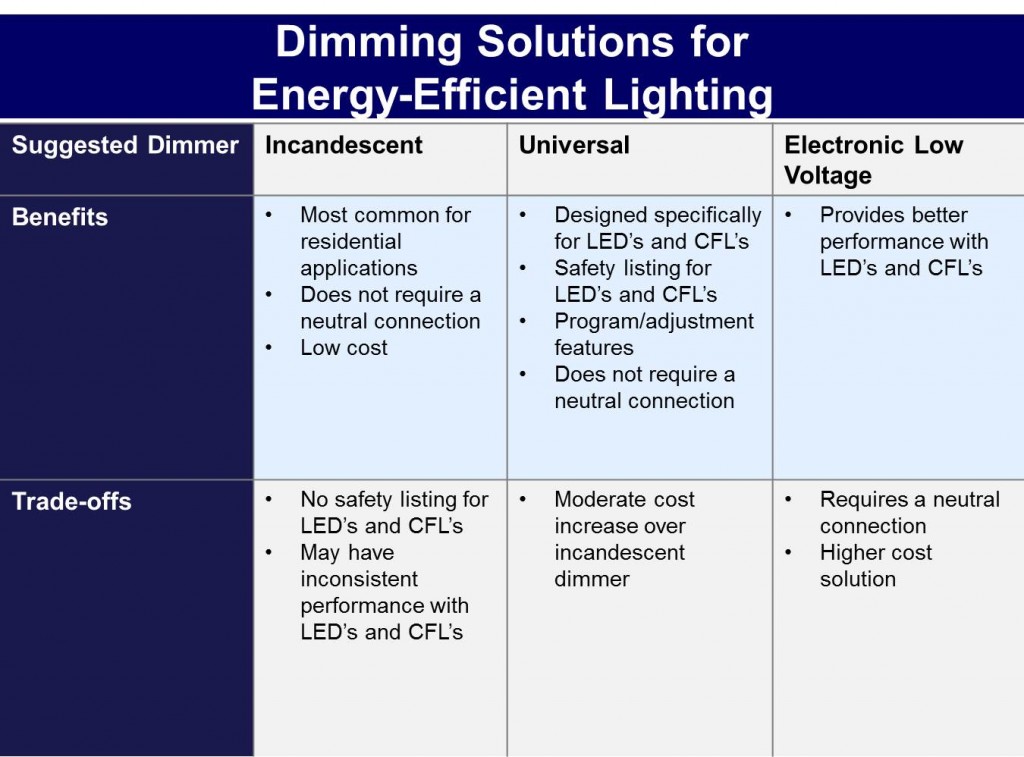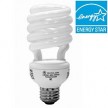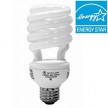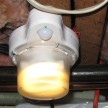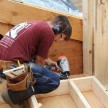Universal Dimmer Switch
The Solution to Today’s Dimming Challenges is Choosing the Right Dimmer
Today consumers have more choices than ever to fulfill their home lighting needs. The days of a simple incandescent bulb and an 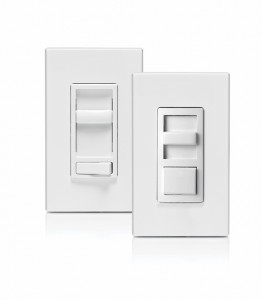 on/off switch have evolved and given way to LEDs, CFLs and the ability for residents to manage both their energy usage and ambiance through the use of dimmers. Evolution, however, is sometimes tricky business.
on/off switch have evolved and given way to LEDs, CFLs and the ability for residents to manage both their energy usage and ambiance through the use of dimmers. Evolution, however, is sometimes tricky business.
Universal Dimmer Switch:
As consumers gravitated to energy-efficient bulbs they made the assumption that their current incandescent dimmer would continue to operate in its usual fashion and seamlessly dim these new bulbs. It did not take long for the market to realize that this was not the case. Performance issues from slow start-up to flickering and fluttering, reduced dimming range and inconsistent illumination were common. At the base of the matter was the compatibility between incandescent dimmers, designed for incandescent bulbs, and the newer LED and CFL bulbs. The engineering behind CFLs and LEDs is more complex than incandescent bulbs so it makes sense that they would require a more sophisticated device to successfully dim them to a customer’s satisfaction. Additionally, consumers need to be aware that even the CFL and LED bulbs they select must be labeled “dimmable” to function properly on a dimmer.
Every application is different and consumers may find that some CFLs and LEDs will work well with incandescent dimmers. However, there are far too many reports of inconsistent performance to ignore. Incandescent dimmers are optimized around the incandescent filament bulb and in general will provide limited performance when used with CFL and LED bulbs. The solution is to install a new dimmer specifically designed and UL listed to dim LED, CFL and incandescent bulbs.
A challenge of many modern lighting controls is the adaptability to both existing and new construction wiring practices. A wallbox may be configured with line and load wires (2-wire) or line, load and neutral wires (3-wire) for connection to a switch or dimmer. Many homes built prior to 2011 have 2-wire configurations whereas home built after 2011 are required by the National Electrical Code to use neutral wires. The challenge is to develop lighting controls that not only work in new construction but also work in all existing homes. Solutions are available and consumers can choose dimmers for 2 wire or 3 wire construction for optimized performance with LED and CFL bulbs.
Instrumental to assuring consumers that their energy-efficient bulbs will work with their new dimmers is coordination between the manufacturers of bulbs and dimmers. Through collaborative partnerships, bulb manufacturers can test their latest CFL and LED bulbs with new dimmers and lighting control manufacturers can test their products on the latest bulb innovations. By working together, companies can cross-reference their products and provide consumers accurate information concerning compatibility and performance based upon testing on both ends of the spectrum. Clearly this effort results in increased end-user satisfaction and is a win-win for all.
In summary, solutions for dimming lights are plentiful in both the bulb and dimmer categories but require some thought to determine the best solution to meet consumer’s needs. In terms of bulbs, the key to dimming energy-efficient bulbs such as LEDs and CFLs is to be certain the selected bulb is labeled “dimmable”. Once individual needs have been determined, selecting the appropriate dimmer is a balancing act between benefits and trade-offs. An ideal solution is Universal Dimmer switch capable of dimming all classes of bulbs – incandescent, LED and CFL. Available for just a moderate cost increase over a standard Incandescent Dimmer, the Universal Dimmer is designed specifically for LED and CFLs so performance, even on hard-to-start CFLs, will be reliable and customers will be satisfied. On the higher end, Electronic Low Voltage Dimmers provide better performance with LEDs and CFLs. However, they are also the most expensive solution and require a neutral connection to operate. The final solution, an Incandescent Dimmer, is the lowest in cost but users generally will see performance issues when pairing it with LEDs and CFLs.
So, as energy-efficient bulbs and new dimming solutions penetrate the market it is important for both installers and homeowners to understand the nuances of these products so they can achieve the maximum benefits of energy-savings and ambiance.



